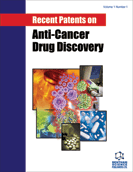
Abstract
Cancer is the main cause of death in developing countries. Its development requires multiple steps in which the occurrence of certain events determines the state transition from a normal to a tumor cell. These events are related to the loss of mechanisms that control various biological processes, which results from the accumulation of genetic alterations, including mutations, chromosomal rearrangements, and variations in gene copy number, as well as from epigenetic alterations. In general, chemotherapeutic agents used for toxicity treatments have shown limited antitumor activity, with a high recurrence rate. This has prompted major research efforts to identify novel effective and selective anti-tumor compounds. In this article, we review recent patents that protect the antitumor properties of natural compounds and related molecules derived from plants, animals, or microorganisms. We consider their structure, mechanism of action, molecular targets and, in some cases, the clinical trial phase reached. We also report on various natural agents that appear to prevent cancer development.
Keywords: Cancer therapy, marine organisms, microorganisms, natural compounds, patent, vegetable.
Recent Patents on Anti-Cancer Drug Discovery
Title:Antitumor Properties of Natural Compounds and Related Molecules
Volume: 8 Issue: 3
Author(s): Inmaculada Robles-Fernandez, Fernando Rodriguez-Serrano, Pablo J. Alvarez, Raul Ortiz, Ana R. Rama, Jose Prados, Consolacion Melguizo, Enrique Alvarez-Manzaneda and Antonia Aranega
Affiliation:
Keywords: Cancer therapy, marine organisms, microorganisms, natural compounds, patent, vegetable.
Abstract: Cancer is the main cause of death in developing countries. Its development requires multiple steps in which the occurrence of certain events determines the state transition from a normal to a tumor cell. These events are related to the loss of mechanisms that control various biological processes, which results from the accumulation of genetic alterations, including mutations, chromosomal rearrangements, and variations in gene copy number, as well as from epigenetic alterations. In general, chemotherapeutic agents used for toxicity treatments have shown limited antitumor activity, with a high recurrence rate. This has prompted major research efforts to identify novel effective and selective anti-tumor compounds. In this article, we review recent patents that protect the antitumor properties of natural compounds and related molecules derived from plants, animals, or microorganisms. We consider their structure, mechanism of action, molecular targets and, in some cases, the clinical trial phase reached. We also report on various natural agents that appear to prevent cancer development.
Export Options
About this article
Cite this article as:
Robles-Fernandez Inmaculada, Rodriguez-Serrano Fernando, Alvarez J. Pablo, Ortiz Raul, Rama R. Ana, Prados Jose, Melguizo Consolacion, Alvarez-Manzaneda Enrique and Aranega Antonia, Antitumor Properties of Natural Compounds and Related Molecules, Recent Patents on Anti-Cancer Drug Discovery 2013; 8 (3) . https://dx.doi.org/10.2174/1574891X113089990034
| DOI https://dx.doi.org/10.2174/1574891X113089990034 |
Print ISSN 1574-8928 |
| Publisher Name Bentham Science Publisher |
Online ISSN 2212-3970 |
 56
56
- Author Guidelines
- Graphical Abstracts
- Fabricating and Stating False Information
- Research Misconduct
- Post Publication Discussions and Corrections
- Publishing Ethics and Rectitude
- Increase Visibility of Your Article
- Archiving Policies
- Peer Review Workflow
- Order Your Article Before Print
- Promote Your Article
- Manuscript Transfer Facility
- Editorial Policies
- Allegations from Whistleblowers
Related Articles
-
Potential Natural Dual Agonist PPARα/γ-induced Antidiabetic and Antidyslipidemic Properties of Safrole-Free Nutmeg Seed (Myristica fragrans Houtt) Extract
The Natural Products Journal Nuclear Medicine: from Photons to Physiology
Current Pharmaceutical Design Role of Non-coding RNA in the Pathogenesis of Intestinal Ischemia- Reperfusion Injury
Current Medicinal Chemistry Air Pollution and Lung Cancer
Current Respiratory Medicine Reviews Urine-derived Stem Cells, A New Source of Seed Cells for Tissue Engineering
Current Stem Cell Research & Therapy Secondary Hypertension: The Ways of Management
Current Vascular Pharmacology Dysregulated Post-Transcriptional Control of COX-2 Gene Expression in Cancer
Current Pharmaceutical Design Antitumor Titanium Compounds
Mini-Reviews in Medicinal Chemistry Protein Interaction Networks in Metallo Proteins and Docking Approaches of Metallic Compounds with TIMP and MMP in Control of MAPK Pathway
Letters in Drug Design & Discovery Conjugates of Cell Adhesion Peptides for Therapeutics and Diagnostics Against Cancer and Autoimmune Diseases
Current Topics in Medicinal Chemistry Combinatorial Therapies for Cardiac Regeneration
Recent Patents on Regenerative Medicine Unfolded Protein Response is Involved in Trans-Platinum (II) Complex-Induced Apoptosis in Prostate Cancer Cells via ROS Accumulation
Anti-Cancer Agents in Medicinal Chemistry Emerging Indications for Statins: A Pluripotent Family of Agents with Several Potential Applications
Current Pharmaceutical Design Synthesis, Characterization, and Molecular Structure of a Novel Zinc (II) Complex: Assessment of Impact of MDR1Pgp Expression on its Cytotoxic Activity
Medicinal Chemistry Current Clinical Applications of In Vivo Magnetic Resonance Spectroscopy and Spectroscopic Imaging
Current Medical Imaging Leucine-zipper and Sterile-α Motif Kinase (ZAK): A Potential Target for Drug Discovery
Current Medicinal Chemistry miR-21, An Oncogenic Target miRNA for Cancer Therapy: Molecular Mechanisms and Recent Advancements in Chemo and Radio-resistance
Current Gene Therapy Interferon-Beta Therapy Monitoring in Multiple Sclerosis Patients
Endocrine, Metabolic & Immune Disorders - Drug Targets Innovations and Improvements in Pharmacokinetic Models Based on Physiology
Current Drug Delivery Preclinical Evaluation of a Monoclonal Antibody (3C6) Specific for Prostate-Specific Membrane Antigen
Current Radiopharmaceuticals
























